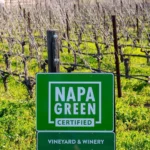Napa RISE Climate & Wine Symposium Shares Solutions for Bottle Reuse, Greener Shipping Methods and More
-
 Katherine Martine | Wine Business monthly
Katherine Martine | Wine Business monthly
- |
Lightweighting glass bottles plays a significant role in helping sustainability by reducing a winery’s carbon emissions, but there are also other effective ways to drive sustainability including using reusable bottles, collecting and recycling film wraps, and choosing alternative shipping materials. These were some of the good practices discussed Wednesday at the third Napa RISE Climate & Wine Symposium hosted by Napa Green at Charles Krug Winery.
The half-day’s worth of sessions centered around the supply chain and waste prevention was the penultimate event of the series of six events for the symposium, which started on April 29 and ended May 8.
Oregon-based wine bottle reuse organization Revino shared information about their efforts in creating more of a circular supply chain with a goal to eliminate single-use packaging.
Oregon-based DANCIN Winery, while they use various lightweight glass, is taking their sustainability efforts a step further by partnering with Revino to offer a fully refillable glass option. This initiative is part of a larger effort by the entire Jacksonville Wine District in Oregon, according to Austin Marca of DANCIN Winery. Marca spoke with WineBusiness Monthly (WBM) in February about their journey to using lightweight glass.
“It’s repackaged and sent back out and that can be to any winery,” Marca said in explaining the reuse process. “Potentially with Oregon’s upcoming Bottle Bill that would also play into [it]. Revino has a special bottle design that can be scanned through the bottle process so it makes it even easier for collection where people can put it right into their green bag or whatever they use for their recycling at home and then it’s dropped off at the facility, scanned and separated out. So they’re very forward thinking in what they’re doing.”
Marca said DANCIN is moving all their Chardonnay to Revino and will start making that transition.
“I think America is a little bit behind the trend of refillable bottles,” he added, noting that refillable bottles are more common in Europe.
Marca said while Revino is pretty new to the market from what he’s heard, they have a pretty good amount of people moving to Revino in Northern Oregon. And while they currently operate in the Willamette Valley of Oregon, they plan to expand to California, according to the RISE Symposium discussion with Adam Rack, co-founder of Revino.
They also want to bring the company’s reuse capabilities to Napa and hope to start pilot projects in the region in four to six months.
Taking a closer look at the elements of a wine bottle and its reusability, being able to reuse labels and label liner backing is also important. The Napa Valley Zero Waste Collective, which was born following the 2023 Napa RISE Climate & Wine Symposium, helps facilitate label backing recycling with the Raflatac group. Michael Garretson, manager, recycling and circular solutions at UPM Raflatac, said with enabling the recycling of label backing, it gets turned into raw polyester and ultimately carpeting. A vintner-led initiative, the Napa Valley Zero Waste Collective also has two established collection facilities for film wrap. The wrap is collected by Trex and turned into sustainable decking, according to presenters.
The Collective can also support recycling of other materials, with pickup options available to wineries.
While physically shipping wine via air or freight can be a thorn in the side to sustainability, so too can the shipping materials. At B Cellars, a DTC-focused winery that produces premium reds and whites, they successfully transitioned to using green cell foam packaging for boxes and insulation. The packaging is derived from U.S.-grown corn—so you could eat it, compost it, or use it as a fire starter since it’s based from corn and is BPI-certified compostable, quipped Curtis Strohl, the general manager at B Cellars.
When they made the switch he said they found that their customers actually liked it better than the Styrofoam as it had more of an aesthetically pleasing appearance than the foam bits and made less of a mess during unpackaging.
Strohl said the corn foam does cost more than the Styrofoam; we justified it as “this is part of our customer experience.” Strohl said once we framed it that way it made a lot of sense.
“This change will remove over 30,000 cubic feet and over 15,000 pounds of styrofoam per year from landfills and commercial waste facilities,” according to the winery, which made the switch to green cell in August 2021.
Leadership in Supply Chain and Waste Prevention
This year the Napa RISE Leadership Award for supply chain and waste prevention was awarded to Clif Family Winery.
Clif Family’s Director of Operations, Sarah Richmond, accepted the award with winemaker Laura Barrett watching from the audience. Sarah likened sustainability work to mountaineering—you want to be able to not carry too much weight but still have the key items you need in your pack. She shared that they ditched foils, screw caps and the special metal bike cogs that adorned their high-end bottles. They started shipping smart with shipping companies like FedEx that are moving to electric vehicle fleets and started insulating shipping boxes with bio-based materials.
In addition, the winery, which is B Corp-Certified, made the move to lightweight glass.
“Overall, we’ve been able to reduce bottle weight across our portfolio by 28% since 2022,” Linzi Gay, president of Clif Family, told WBM.
Clif initially trialed their first lightweight glass in early 2023 for 750ml bottles, including both Burgundy- and Bordeaux-style wine bottles. In looking at their transition to lighter glass, Gay shared the changes the winery made over time:
• 2022 – Avg. 750ml bottle weighed 562g
• 2023 – Avg. 750ml bottle weighed 529g
• 2024 – Avg. 750ml bottle weighed 420g


